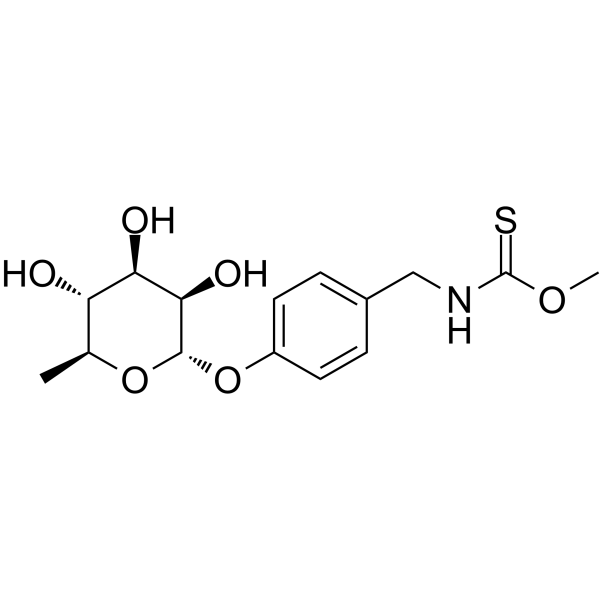Physicochemical Properties
| Molecular Formula | C15H21NO6S |
| Molecular Weight | 343.39534 |
| Exact Mass | 343.108 |
| CAS # | 147821-57-6 |
| PubChem CID | 10088810 |
| Appearance | Off-white to light yellow solid powder |
| LogP | 0.4 |
| Hydrogen Bond Donor Count | 4 |
| Hydrogen Bond Acceptor Count | 7 |
| Rotatable Bond Count | 5 |
| Heavy Atom Count | 23 |
| Complexity | 390 |
| Defined Atom Stereocenter Count | 5 |
| SMILES | CC1C(C(C(C(O1)OC2=CC=C(C=C2)CNC(=S)OC)O)O)O |
| InChi Key | ZOIAMMQYAZSWRX-CNJBRALLSA-N |
| InChi Code | InChI=1S/C15H21NO6S/c1-8-11(17)12(18)13(19)14(21-8)22-10-5-3-9(4-6-10)7-16-15(23)20-2/h3-6,8,11-14,17-19H,7H2,1-2H3,(H,16,23)/t8-,11-,12+,13+,14-/m0/s1 |
| Chemical Name | O-methyl N-[[4-[(2S,3R,4R,5R,6S)-3,4,5-trihydroxy-6-methyloxan-2-yl]oxyphenyl]methyl]carbamothioate |
| HS Tariff Code | 2934.99.9001 |
| Storage |
Powder-20°C 3 years 4°C 2 years In solvent -80°C 6 months -20°C 1 month Note: This product requires protection from light (avoid light exposure) during transportation and storage. |
| Shipping Condition | Room temperature (This product is stable at ambient temperature for a few days during ordinary shipping and time spent in Customs) |
Biological Activity
| ln Vitro | At a significantly greater concentration (CC50 of 31.6 µM) than its antileishmanial concentration (IC50 of 5.25 µM), niazinin is cytotoxic[1].. |
| References |
[1]. Antileishmanial compounds from Moringa oleifera Lam. Z Naturforsch C J Biosci. Mar-Apr 2014;69(3-4):110-6. [2]. Structure-based virtual screening, molecular dynamics and binding affinity calculations of some potential phytocompounds against SARS-CoV-2. J Biomol Struct Dyn. 2021 Mar 8;1-18. |
| Additional Infomation | Niazinin has been reported in Moringa oleifera with data available. |
Solubility Data
| Solubility (In Vitro) | DMSO : ≥ 50 mg/mL (145.60 mM) |
| Solubility (In Vivo) |
Solubility in Formulation 1: 2.5 mg/mL (7.28 mM) in 10% DMSO + 40% PEG300 + 5% Tween80 + 45% Saline (add these co-solvents sequentially from left to right, and one by one), clear solution; with sonication. For example, if 1 mL of working solution is to be prepared, you can add 100 μL of 25.0 mg/mL clear DMSO stock solution to 400 μL PEG300 and mix evenly; then add 50 μL Tween-80 to the above solution and mix evenly; then add 450 μL normal saline to adjust the volume to 1 mL. Preparation of saline: Dissolve 0.9 g of sodium chloride in 100 mL ddH₂ O to obtain a clear solution. Solubility in Formulation 2: 2.5 mg/mL (7.28 mM) in 10% DMSO + 90% (20% SBE-β-CD in Saline) (add these co-solvents sequentially from left to right, and one by one), clear solution; with ultrasonication. For example, if 1 mL of working solution is to be prepared, you can add 100 μL of 25.0 mg/mL clear DMSO stock solution to 900 μL of 20% SBE-β-CD physiological saline solution and mix evenly. Preparation of 20% SBE-β-CD in Saline (4°C,1 week): Dissolve 2 g SBE-β-CD in 10 mL saline to obtain a clear solution. (Please use freshly prepared in vivo formulations for optimal results.) |
| Preparing Stock Solutions | 1 mg | 5 mg | 10 mg | |
| 1 mM | 2.9121 mL | 14.5603 mL | 29.1206 mL | |
| 5 mM | 0.5824 mL | 2.9121 mL | 5.8241 mL | |
| 10 mM | 0.2912 mL | 1.4560 mL | 2.9121 mL |
